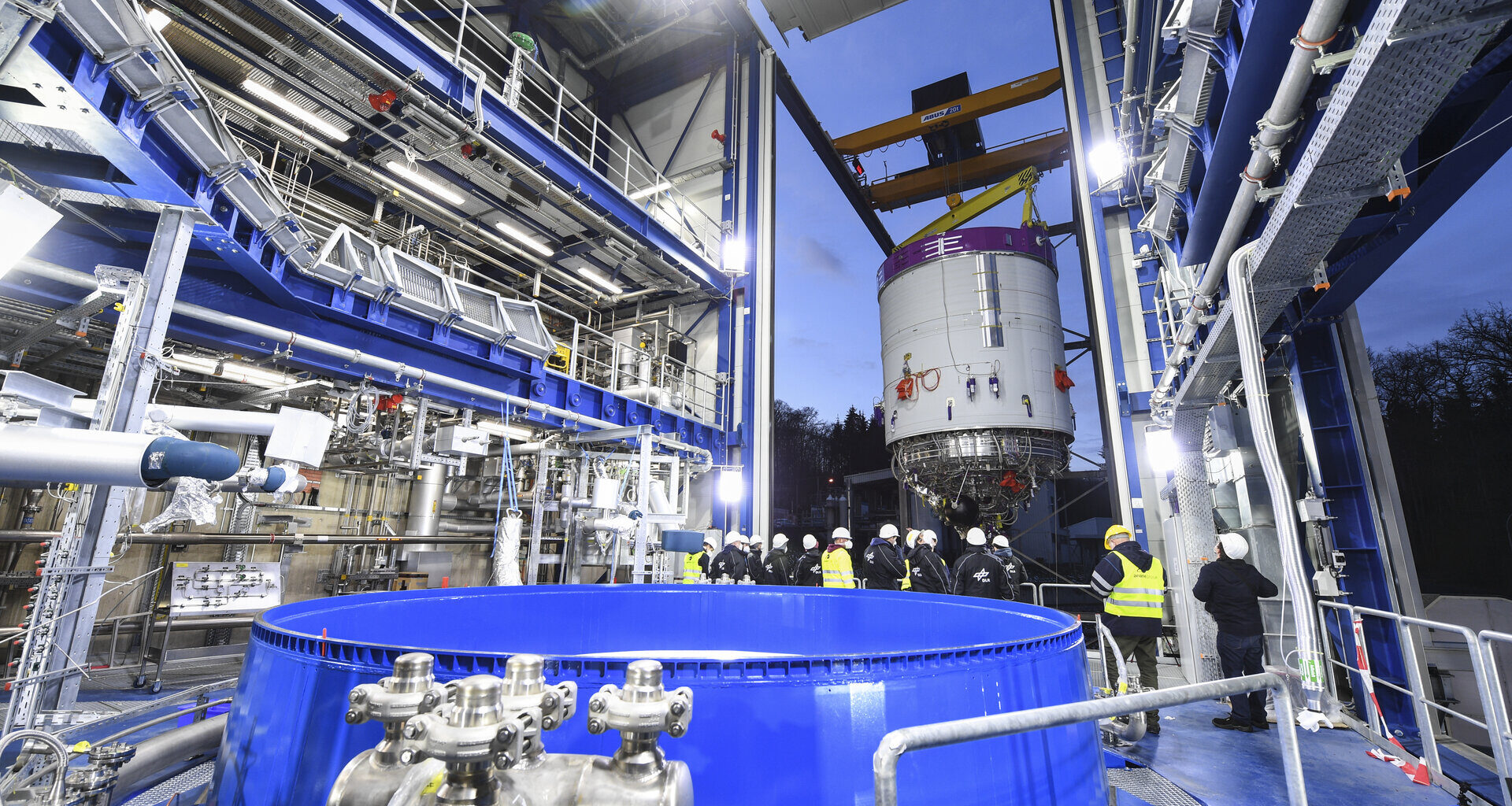Enabling & Support
17/10/2025
240 views
1 likes
In the 16th century, German fireworks maker Johann Schmidlap developed one of the first two-staged rockets, and the staged technique of rocketry is still used to launch rockets such as the Ariane 6 into orbit today. As one of the largest contributors to the Ariane 6 programme, Germany carries Schmidlap’s legacy forward, providing 20.8% of the funding and supplying several parts for Europe’s heavy-lift rocket.
The upper stage for Ariane 6 is tested at the P5.2 test bench at Germany’s DLR centre for engine and stage testing in Lampoldshausen, Germany. It provides operating conditions representative of a flight from Europe’s Spaceport in French Guiana, with the exception of vacuum and microgravity.
This series of articles is looking at the parts and components needed to assemble the Ariane 6 rocket – supplied by companies from the 13 ESA Member States participating to the Ariane 6 programme. Together they contribute the best of their know-how to build Europe’s heavy-lift launcher under the guidance of main contractor ArianeGroup who also designed the Ariane 6 rocket.
Not-so-heavy metals
MT Aerospace production hall for Ariane 6
MT Aerospace is responsible for making the upper and core inter-tank structures, the upper and core stage tanks, parts of the Vulcain 2.1 engine and the front and rear skirts for the boosters. Taken together, these components account for approximately 10% of the launcher.
The upper and core stage tanks and inter tank structures are made of aluminium lithium, a lightweight alloy that maximises durability and minimises weight. MT Aerospace also introduced an innovative method to form components by integrating artificial intelligence into the ‘shot peening’ process of improving the metal by striking it repeatedly to help increase the performance and decrease the cost of the new launcher.
Helium under pressure
Enrichment Technology Company designed, developed, qualified and manufactures the carbon fibre helium tanks for Ariane 6. The tanks are used on both stages of the rocket. Standing just over a metre high and 80 cm in diameter, each tank holds 374 litres of helium and can operate at pressures up to 400 times that of Earth’s atmosphere. The unique “Type-IV” design, is plastic-liner wrapped with carbon and weighs much less than traditional metallic tanks.
Unlike the liquid hydrogen and liquid oxygen that fuel the rocket, helium is a nonreactive gas. It is used to pressurise the fuel tanks, pushing the liquid oxygen and hydrogen to the combustion chamber. It’s also used in the Ariane 6 cooling systems.
Providing propulsion
Ariane 6 is designed and built under the responsibility of the ArianeGroup, which includes both French and German subsidiaries. The German branch manufactures the thrust chamber for both the Vinci and Vulcain 2.1 engines. The German and French branches of ArianeGroup work together to produce the Auxiliary Propulsion Unit, which pressurises the upper stage tanks and prepares the Vinci engine for reignition. It can also be used to deorbit the upper stage at the end of the mission, supporting ESA’s Zero Debris approach.
Putting it all together
Once the many components of Ariane 6 have been manufactured, the upper stage is put together in ArianeGroup’s assembly hall in Bremen, Germany. In this high-tech facility, the upper stage tanks and fuel lines are prepared to perfection. Cleanliness is essential as even a single contaminating fingerprint could cause a catastrophic reaction in the liquid oxygen tank.
In addition to the usual bolting and connecting of rocket parts, the Bremen site uses a novel method to install foam insulation on the upper stage. In this method, a laser over 2000 times more powerful than a laser pointer roughens up the metal exterior before a robot arm sprays foam insulation equally over the surface. This insulation is essential for keeping the liquid hydrogen cooled to –250 °C and liquid oxygen cooled to –180 °C even when the temperatures on the launch pad in French Guiana exceed 30 °C.
After assembly, the upper stage makes an 8 km trip to the Bremen harbour for loading onto the Canopée sail ship bound for French Guiana. To avoid inconveniencing the Bremen locals, the 18-tonne, 5.4 m wide upper stage is transported in the dead of night. But if you are unlucky, you might get stuck behind a rocket on your way home from the nightshift, or club.
Rocket on the move – Ariane 6 upper stage transport timelapse
Like

